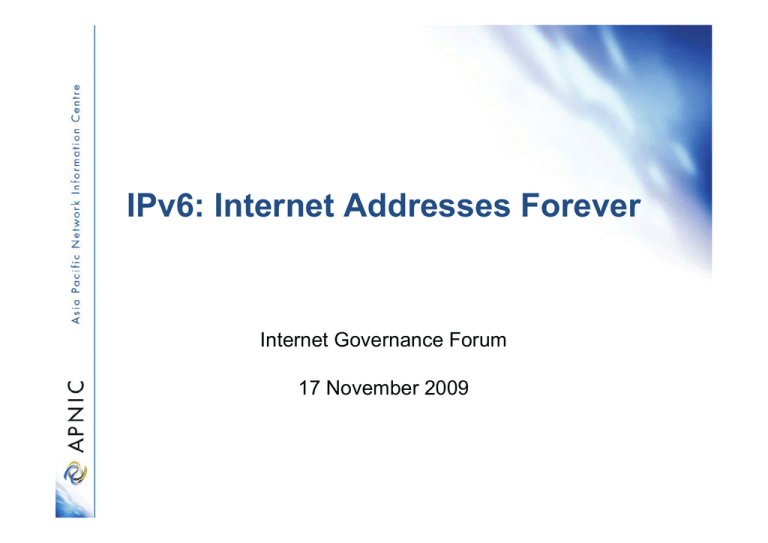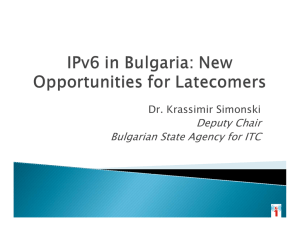IPv6: Internet Addresses Forever Internet Governance Forum 17 November 2009
advertisement

IPv6: Internet Addresses Forever Internet Governance Forum 17 November 2009 Overview • • • • • Motivation for IPv6 IP Address Status IP Address management The Next Step: IPv6 Conclusions The “Narrow Waist” Network Infrastructure Voice Video Data Applications Phone/Fax/SMS TV/VOD/conf “The Internet” Fixed, Dialup/ISDN Mobile/2G Cable/ADSL The “Narrow Waist” – Tomorrow Network IP over Everything 4 IP Everything over IP Voice, email, IM Video, TV, conf WWW+++ 802.11*/WiMax Mobile/3G Cable/*DSL FTTH, ETTH IPv4 Consumption: Projection Projected IANA Pool Exhaustion: 27 July 2011 Projected RIR Pool Exhaustion: 19 May 2012 A quick summary • IPv4 addresses are a finite resource – Only about 10% remain • But the demand for IP addresses will keep growing – More devices are requiring IP addresses – IP addresses are a pre-requisite for broadband penetration • The remaining 10% is not large enough to support such demand • IPv6 is the only solution ! IPv6 Allocations RIRs to LIRs/ISPs How many allocations have been made by each RIR by year? June 2009 Internet Number Resource Report IPv6 deployment IPv6 routes 2,200 IPv4 routes 310,000 IPv6 ASNs 1,700 IPv4 ASNs 33,000 How are IP Addresses Managed? • Regional Internet address Registries – – – – Open membership-based industry bodies Non-profit, neutral, and independent Allocation, registration and other services Other services as required • First established in early 1990s – Voluntarily by consensus of community – To ensure responsible address management, according to technical and administrative needs – To support Internet development • In the “Internet tradition” – Consensus-based, open, and transparent Regional Internet Registries 1992: “…it is [now] desirable to consider delegating the registration function to an organization in each of those geographic areas.” (RFC 1338) Open Policy Processes Need Anyone can participate OPEN Evaluate BOTTOM UP Implement Internet community proposes and approves policy Discuss TRANSPARENT Consensus All decisions & policies are documented & freely available to anyone http://www.nro.net Where are we now • IPv6 addresses are easy to obtain – Policies are established and stable – Minimal barriers to allocations – No reservations, but supply is huge • IPv6 deployment strongly encouraged – Increasing promotion and awareness – Technical training and support • Readiness is increasing and deployment is underway Government Responses • Promote IPv6 – To ISP and telco Industries – Encourage IPv6 readiness if not deployment – Opportunity to “leapfrog” to latest technology • Specify IPv6 – Government equipment procurement – Network servers and services – Public infrastructure deployments • Require IPv6 – To the extent possible (cf digital TV) The IPv4 revolution • The 1990’s – a new world of… – Cheaper bandwidth, switching – Lower operational costs – The PC revolution, funded by users • The Internet boom – The dumb (and cheap) network – Technical and business innovation at the edges – Many compelling business cases for new services and innovation An IPv6 revolution… • The 2010’s – a new world of… – Commodity Internet: Broadband, mobile, alwayson – Massive reduction in cost of consumer electronics – A network-ready society • An IPv6 boom? – – – – One unified ubiquitous pervasive network 2–3 orders of magnitude larger than today “Internet for Everything” Bringing online the “Next 6 Billion” • Let’s get ready for IPv6 ! Thanks Paul Wilson Director General APNIC pwilson@apnic.net


